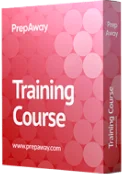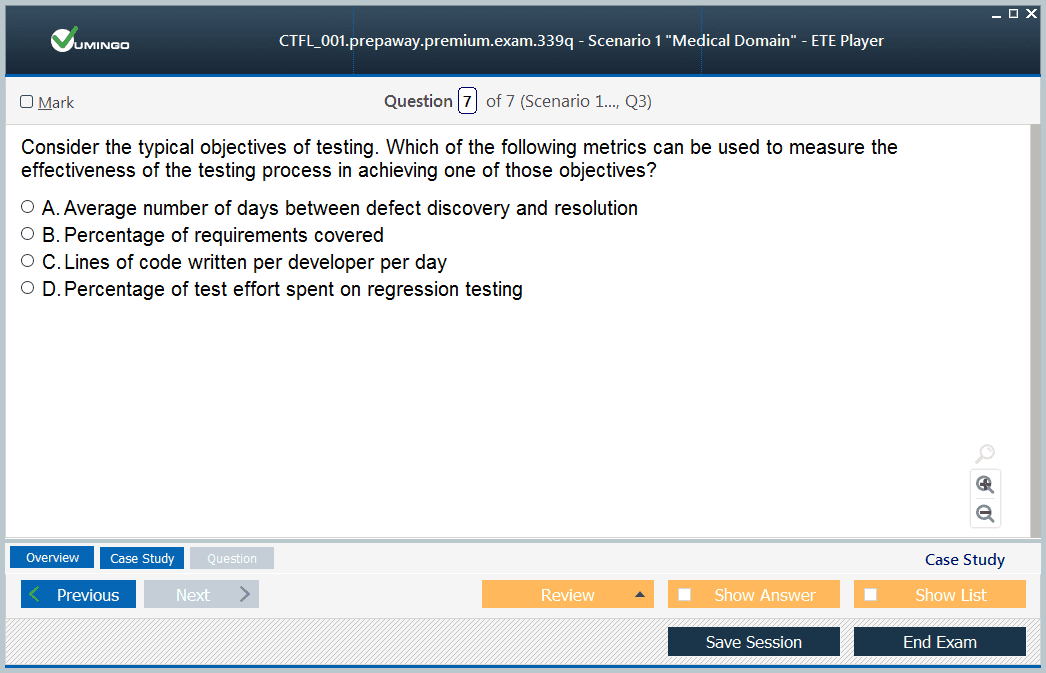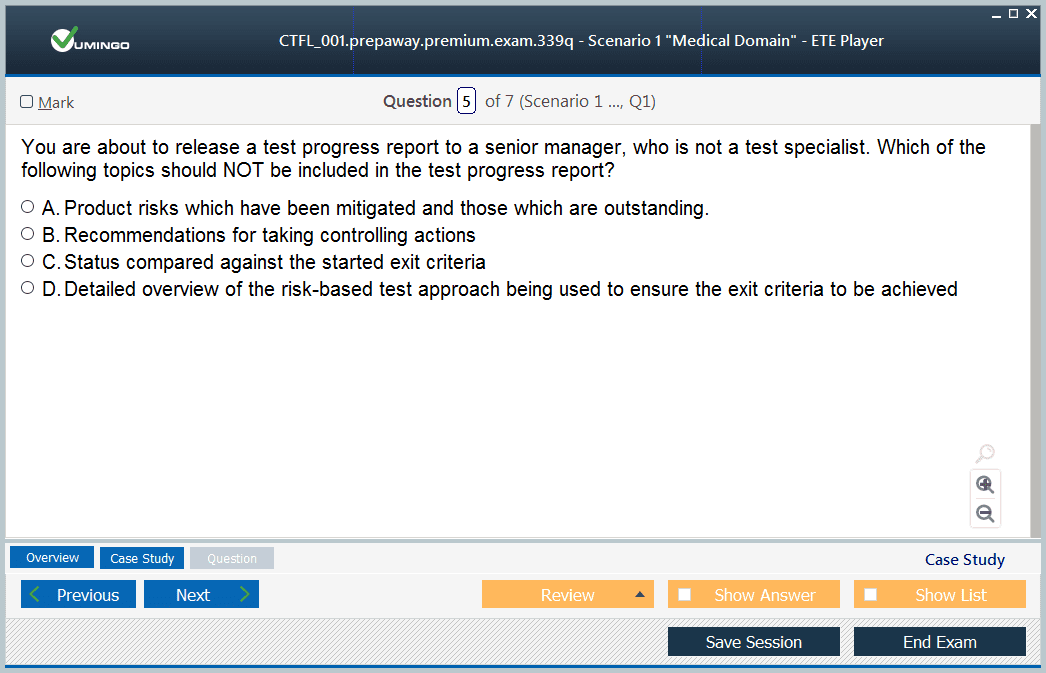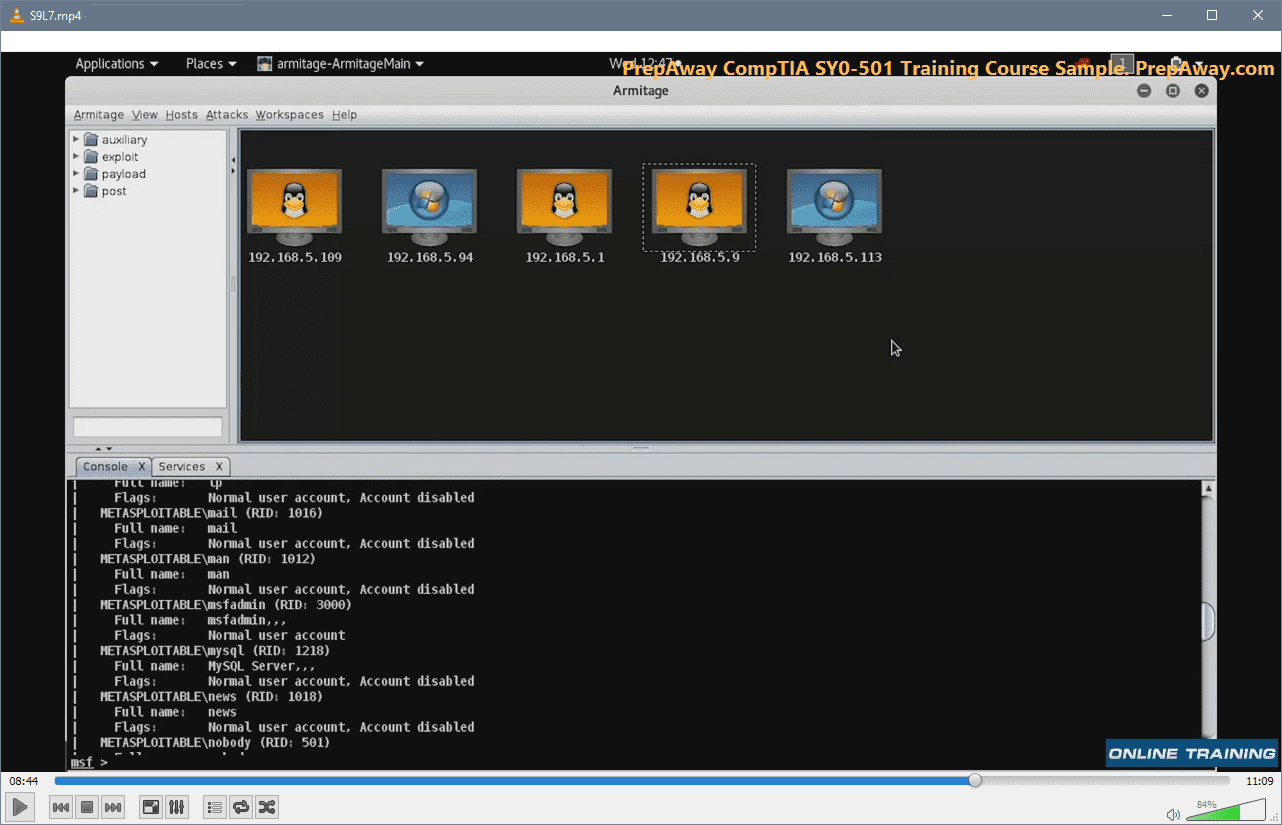- Home
- iSQI Certifications
- CTFL_001 ISTQB Certified Tester Foundation Level (CTFL_001) Dumps
Pass iSQI CTFL_001 Exam in First Attempt Guaranteed!
Get 100% Latest Exam Questions, Accurate & Verified Answers to Pass the Actual Exam!
30 Days Free Updates, Instant Download!


CTFL_001 Premium Bundle
- Premium File 339 Questions & Answers. Last update: Dec 18, 2025
- Training Course 75 Video Lectures
Last Week Results!

Includes question types found on the actual exam such as drag and drop, simulation, type-in and fill-in-the-blank.

Based on real-life scenarios similar to those encountered in the exam, allowing you to learn by working with real equipment.
All iSQI CTFL_001 certification exam dumps, study guide, training courses are Prepared by industry experts. PrepAway's ETE files povide the CTFL_001 ISTQB Certified Tester Foundation Level (CTFL_001) practice test questions and answers & exam dumps, study guide and training courses help you study and pass hassle-free!
Certified Tester Foundation Level (CTFL-001) Exam Preparation
The iSQI Certified Tester Foundation Level CTFL-001 exam is one of the most recognized certifications for software testing professionals. It introduces learners to the fundamental concepts of software testing and builds a solid foundation to pursue advanced testing certifications. This course is designed to provide candidates with structured training that aligns with the CTFL-001 exam objectives while also enhancing real-world skills. The course will cover testing principles, processes, tools, and techniques that are crucial for professionals working in quality assurance and software testing environments.
This preparation course is created to not only help participants succeed in the certification exam but also to build a comprehensive understanding of how software testing integrates into modern software development. The curriculum focuses on concepts that are globally recognized and applicable across various industries, making it a valuable credential for both beginners and experienced professionals.
By the end of this training, participants will gain confidence in test design techniques, software development lifecycle models, static and dynamic testing approaches, defect management, and essential testing tools. It will provide them with the ability to approach projects with the knowledge of international testing standards and best practices.
Importance of the Certification
The CTFL-001 certification demonstrates a professional’s understanding of software testing at the foundation level. Employers recognize this certification as evidence of commitment to quality and competence in the field of software testing. It is an entry point for professionals aspiring to advance in the testing and quality assurance domains. With technology growing rapidly, organizations need individuals who understand how to ensure product quality through efficient testing processes, and this certification provides that assurance.
Course Requirements
This training course is designed to be accessible to a wide range of learners. No prior testing certification is required, but participants should ideally have a basic understanding of software development concepts. Knowledge of programming is not mandatory, but familiarity with software projects will help learners grasp the content more effectively.
Participants should also have strong analytical thinking and a keen interest in understanding software quality. Since testing is about identifying errors, validating processes, and ensuring customer satisfaction, learners should be detail-oriented and willing to approach problems logically.
The course can be taken by students, working professionals, or individuals preparing for their first role in the software industry. A willingness to study the provided materials and practice sample questions is essential for success in the certification exam.
Course Description
This preparation course provides an in-depth study of the syllabus covered by the iSQI CTFL-001 certification exam. It introduces the foundations of testing, covering concepts such as why testing is required, the fundamental test process, and the psychological aspects of testing. It also explains software development lifecycle models and their relationship to testing, including waterfall, agile, and iterative approaches.
The course covers static techniques, reviews, and the importance of static testing in defect prevention. Learners will explore test design techniques such as equivalence partitioning, boundary value analysis, decision tables, state transition testing, and exploratory testing. Defect management, incident reports, and the cycle of defect handling are explained thoroughly.
An important part of this course is the exposure to test tools and automation basics. While it is a foundation-level course, it introduces learners to how tools support the testing process, from test management tools to performance testing utilities. By building a balance between theory and practice, learners will acquire both exam readiness and workplace relevance.
Who This Course Is For
The course is intended for individuals who are new to software testing and want to establish their careers in this domain. It is equally valuable for professionals already working in development, business analysis, or project management who wish to gain a strong understanding of software testing principles.
It is particularly beneficial for the following groups of learners. Fresh graduates entering the IT industry who want to strengthen their career prospects with an internationally recognized credential. Software testers in entry-level roles seeking to validate their knowledge and improve their confidence. Developers who want to expand their knowledge of testing practices to build higher quality software. Quality assurance professionals looking for a globally acknowledged certification to advance their careers.
Project managers and team leaders can also benefit from this course as it helps them better understand how testing activities align with project goals. Even business analysts can take this course to learn how to contribute to test planning and execution in their organizations.
Modules in This Course
The training is divided into modules that systematically cover all areas of the CTFL-001 syllabus. Each module is carefully designed to build understanding progressively so learners can prepare step by step for the certification exam.
The first module introduces the principles of software testing and explains the importance of testing in the software development process. Learners will understand testing as a way to uncover errors, prevent failures, and ensure that requirements are met. This sets the stage for further exploration.
The second module focuses on testing throughout the software development lifecycle. Different lifecycle models such as waterfall, V-model, and agile are explained with their unique testing strategies. The role of testers in each model is discussed, along with advantages and challenges.
The third module introduces static testing techniques, including reviews and static analysis. Learners will study how early defect detection through static methods reduces cost and improves software quality. Review processes and roles are explained in detail.
The fourth module explores test design techniques. It provides practical guidance on using black-box, white-box, and experience-based approaches. Learners will practice equivalence partitioning, boundary value analysis, decision table testing, and other key techniques.
The fifth module addresses test management and defect management. It covers test planning, monitoring, control, and reporting. Learners will understand how to manage incidents and handle them in an organized way to improve the testing cycle.
The sixth module introduces tool support for testing. It explains the different categories of tools available, from test execution tools to performance testing tools. Learners will understand how tools fit into the testing process and how automation can support but not replace testers.
Learning Approach
The course uses a structured learning approach that combines explanations, examples, and practice. Learners will engage with real-world scenarios that demonstrate how testing principles are applied in practice. Alongside theoretical learning, sample exam-style questions are provided to help participants become familiar with the format and expectations of the actual exam.
Practical exercises are integrated into the modules to ensure that learners not only memorize concepts but also understand how to apply them. Case studies and examples from industry practice strengthen the knowledge gained and make it easier for learners to transfer the skills to their workplaces.
Foundations of Software Testing
Software testing begins with a clear understanding of its purpose. The role of testing is not simply to find bugs but to ensure that software behaves as intended and delivers value to users. Many people assume testing is only about execution, but the process is far broader. It includes planning, static techniques, documentation, and reporting. Testing confirms that requirements are met, identifies deviations, and prevents costly failures in production. It is also a way to build confidence in the product. When developers and stakeholders know that testing has been conducted thoroughly, they are assured that risks have been minimized.
The foundation of testing also lies in understanding that errors, defects, and failures are distinct. An error is a human mistake in coding or design. A defect is the manifestation of that error in the software. A failure is when the defect is executed and causes unexpected behavior. Recognizing these distinctions helps testers adopt a scientific approach to the testing process.
Principles of Testing
Testing is guided by several principles that remain valid regardless of technology or methodology. One principle states that testing shows the presence of defects but not their absence. Even if extensive testing is carried out, there can never be complete certainty that software is defect free. Another principle emphasizes that exhaustive testing is impossible. Since software systems can have infinite input combinations and execution paths, testers must focus on risk-based and prioritized testing.
Testing should start early in the software lifecycle. Defects detected early are cheaper to fix than those found later in development or after release. Another principle is that defect clustering often occurs, meaning a small number of modules contain most of the defects. Testers can use this insight to direct more effort where risks are higher. Testing is also context dependent. A financial system requires different testing than a gaming application. Finally, the principle known as the pesticide paradox explains that repeating the same tests will eventually stop finding new defects. Therefore, test cases must be reviewed and improved regularly.
The Test Process
The test process is structured into activities that guide how testing should be conducted. Test planning is the initial step. It involves defining objectives, identifying resources, setting schedules, and establishing the scope. A clear plan ensures testing aligns with project goals and business needs. The next step is monitoring and control, where progress is tracked against the plan and adjustments are made when deviations occur.
Test analysis is performed to determine what to test and how to test it. Test design follows, where test cases and data are created. Test implementation then prepares the environment, test suites, and execution order. Test execution is where planned tests are carried out, and results are recorded. Incidents such as defects or unexpected outcomes are logged for investigation. Finally, test completion summarizes all activities, evaluates objectives, and delivers reports to stakeholders.
Understanding this process is critical for the certification exam and also for practical application in projects. Each activity requires documentation, communication, and alignment with business objectives.
Testing Throughout the Software Lifecycle
Software testing is not a one-time activity but a continuous process throughout the lifecycle. In traditional waterfall models, testing is conducted after development phases, but this approach often leads to late detection of defects. The V-model introduced the idea that testing activities should be associated with each development stage. For example, requirement specifications are verified by acceptance testing, design is validated by system testing, and modules are verified by unit testing.
Agile models integrate testing throughout short iterations. Testers work closely with developers, often using practices like test-driven development and continuous integration. Regression testing becomes frequent to ensure that new changes do not introduce errors in previously working code. Iterative models also emphasize repeated cycles of development and testing.
Each lifecycle requires testers to adapt their techniques. In agile, collaboration and automation are essential. In waterfall, structured planning and documentation take priority. Testers must be flexible in applying their knowledge depending on the environment.
Static Testing Techniques
Static testing involves evaluating software work products without executing them. It helps detect defects early, saving cost and effort. Reviews are one of the most common static techniques. A walkthrough involves peers discussing a work product to identify potential improvements. An inspection is more formal, with roles such as moderator, reader, and recorder ensuring structured analysis. Static analysis tools automatically examine code to detect vulnerabilities, inconsistencies, or compliance issues.
Static testing is not limited to code. Requirements, design documents, and test plans can also be reviewed. By identifying ambiguities or missing details early, teams prevent issues from progressing into later stages. The importance of static testing is highlighted in the exam syllabus because it reflects real-world value. Organizations that embrace reviews and static analysis often deliver higher quality software faster.
Test Design Techniques
Designing effective test cases is at the heart of testing. Black-box techniques derive test cases from external descriptions such as requirements without looking at the internal code. Equivalence partitioning divides input data into valid and invalid classes, reducing the number of test cases while ensuring coverage. Boundary value analysis focuses on the edges of input ranges, where defects are most likely to appear. Decision table testing helps in complex business rules by creating combinations of conditions and actions. State transition testing verifies systems that behave differently depending on prior states.
White-box techniques use the internal structure of the software. Statement coverage and branch coverage ensure that code paths are executed during testing. This reduces the chance of undiscovered defects. Experience-based techniques rely on tester knowledge, intuition, and exploratory testing. While less formal, they often uncover issues that structured techniques miss.
Each technique has its strengths and limitations. For certification purposes, candidates must know when and how to apply them. For workplace purposes, testers often combine techniques to maximize coverage.
Test Management
Managing testing activities is critical for success. Test management includes planning, estimation, scheduling, and monitoring. Test managers ensure that testing resources are allocated effectively, risks are identified, and objectives are met. They coordinate between testers, developers, and stakeholders to keep the process aligned.
Test documentation is another key aspect. Plans, cases, logs, and summary reports must be created to ensure traceability. Without documentation, it becomes difficult to prove what was tested, what defects were found, and whether objectives were achieved. The exam requires candidates to know different types of documentation and their purposes.
Risk-based testing is an important strategy in management. It prioritizes testing efforts based on potential impact and likelihood of failure. By focusing on critical areas, teams maximize the value of their limited resources.
Defect Management
Defects are inevitable in software development, but managing them effectively makes the difference between project success and failure. The defect lifecycle includes identification, logging, categorization, resolution, retesting, and closure. A defect report must contain details such as severity, priority, steps to reproduce, expected results, and actual results. Clear reports help developers fix issues quickly.
Defect management also involves tracking metrics such as defect density, open versus closed defects, and average resolution time. These metrics provide insight into product quality and team performance. Communication between testers and developers is essential. Instead of blaming, teams should treat defects as opportunities to improve processes and prevent similar issues in the future.
Tool Support for Testing
Tools play an increasing role in modern testing. Test management tools help plan, execute, and track testing activities. Test execution tools automate repetitive tasks and improve efficiency. Performance testing tools simulate load and measure how software behaves under stress. Static analysis tools identify code vulnerabilities.
While tools enhance productivity, they do not replace testers. Human judgment, creativity, and understanding of context remain irreplaceable. Tools should support testers by reducing effort in repetitive tasks, enabling them to focus on exploratory and analytical work.
When preparing for the exam, candidates should understand the benefits and risks of tools, categories of tools, and the steps involved in implementing them successfully in an organization.
Exam Preparation Strategies
Success in the CTFL-001 exam requires structured preparation. Candidates should begin by understanding the exam syllabus in detail. Each topic has specific learning objectives ranging from knowledge to application. Study materials, including this training course, should be reviewed thoroughly.
Practice questions are vital. They help candidates become familiar with the style of questions and the level of detail expected. Time management during practice sessions builds confidence for the actual exam. Candidates should also review definitions from the ISTQB glossary, as terminology forms a core part of the exam.
Creating a personal study plan ensures regular progress. Candidates should set aside dedicated hours each week and revise continuously. Group discussions, online forums, and study partners can also enhance understanding.
Building Real-World Skills
Although the main goal may be certification, the real value of this course lies in developing practical skills. Testers must be able to communicate effectively with developers and stakeholders. They must analyze requirements, design meaningful test cases, and manage defects professionally. This course encourages learners to go beyond theory and build habits that make them effective in projects.
Practical application also includes adapting to agile environments, using automation tools, and participating in continuous integration pipelines. These experiences prepare testers for the realities of the workplace.
Agile Testing Fundamentals
Agile methodologies have transformed the way software is developed, and testing has evolved alongside them. Agile testing is not a separate phase at the end of development but an integral activity throughout iterations. Testers collaborate closely with developers, product owners, and customers to ensure that quality is built into the product from the beginning. The goal is to provide continuous feedback so that teams can adapt quickly to changing requirements.
Agile testing emphasizes communication and collaboration. Testers often join daily stand-ups, sprint planning, and retrospectives. This involvement allows them to influence design decisions early and prevent defects before they occur. The mindset of agile testing is proactive rather than reactive, focusing on preventing problems rather than just detecting them.
Role of Testers in Agile Teams
In agile projects, testers are not gatekeepers at the end but quality advocates throughout. Their responsibilities include clarifying acceptance criteria, designing tests alongside developers, and automating repetitive checks. Testers also help in exploratory testing, where creativity and intuition guide the discovery of hidden issues. They pair with developers during test-driven development sessions to ensure that code is written with testing in mind.
The tester’s role extends to coaching the team about quality practices. They encourage developers to write unit tests, product owners to specify precise requirements, and the whole team to think about usability and performance. This holistic contribution makes testers valuable members of agile teams.
Test Levels in Agile Projects
Even though agile projects move quickly, test levels remain essential. Unit testing is heavily emphasized, with developers writing automated tests to validate small components of code. Integration testing ensures that modules work together as expected. System testing validates the entire application against requirements. Acceptance testing verifies that the product meets customer expectations and business value.
In agile, acceptance testing often takes the form of behavior-driven development or specification by example. Here, requirements are written as scenarios with concrete examples, which double as acceptance tests. This approach improves communication and ensures shared understanding among team members.
Exploratory Testing in Agile
Exploratory testing becomes even more important in agile because rapid iterations mean less time for formal documentation. Testers explore the application, design tests on the fly, and adapt based on what they learn. This method uncovers defects that scripted tests might miss. It is especially useful for finding usability issues, unexpected behavior, or edge cases that automated checks overlook.
Exploratory testing is structured with charters, where testers define goals for their sessions. They document observations, defects, and insights during the process. This balance of creativity and discipline makes exploratory testing a powerful practice in agile environments.
Automation in Agile Testing
Automation is critical in agile projects because frequent changes require rapid feedback. Automated unit tests, integration tests, and regression tests provide this feedback. Continuous integration systems execute these tests whenever new code is added, ensuring that defects are detected early.
Testers contribute by identifying what should be automated and by creating higher-level automated checks such as user interface tests or API tests. However, automation cannot cover everything. Human testing remains necessary for exploratory activities, usability validation, and complex scenarios. A balanced strategy combining automation with manual exploration delivers the best results.
Risk-Based Testing in Agile
Agile projects often face tight deadlines and limited resources, making risk-based testing an essential approach. Testers analyze features based on their business impact and likelihood of failure. High-risk features receive more testing effort, while low-risk areas may receive less attention. This prioritization ensures that critical functionality is validated even under time constraints.
Risk assessment is not static. Testers continuously update risk evaluations as new information arises. For example, if a new feature integrates with multiple components, the risk level increases, and testing focus shifts accordingly. This adaptability helps agile teams stay responsive and effective.
Sample Scenarios for Exam Preparation
Understanding theory is important, but applying it to scenarios is key for exam success. One scenario could involve a project using the waterfall model where testing only begins after coding. The question may ask candidates to identify the risks, such as late defect detection and higher cost of fixes. Another scenario could describe an agile project and ask how testers contribute to acceptance criteria. Candidates would need to explain how testers collaborate with product owners and developers to refine requirements.
A scenario might also present a defect report with missing details. Candidates would need to identify which information should be included, such as severity, priority, steps to reproduce, and expected results. Another common exam scenario could involve selecting the most appropriate test design technique for a given situation. For instance, boundary value analysis for input ranges or decision tables for business rules.
Mock Exam Practice
Practicing exam-style questions is essential for building confidence. Multiple choice questions typically test both recall and application. A sample question could ask: Which of the following is a principle of testing? Options might include exhaustive testing is possible, testing shows the absence of defects, testing should start early, or testing is independent of context. The correct answer is that testing should start early.
Another sample could ask which test technique is most suitable when testing complex combinations of conditions. The answer would be decision table testing. By practicing similar questions, candidates not only prepare for the exam format but also reinforce their understanding of concepts.
Time management is another focus. The exam is timed, so candidates should practice completing questions under time constraints. Skipping difficult questions and returning later is a useful strategy. Reviewing answers carefully before submission also helps avoid mistakes.
Applying Knowledge in the Workplace
Beyond the exam, this knowledge has real-world impact. Testers apply principles of early testing by participating in requirement reviews. They use design techniques to create efficient and effective test cases. They manage defects with clear communication and maintain documentation to ensure traceability.
In agile projects, testers apply risk-based strategies, contribute to automation frameworks, and perform exploratory sessions. In traditional projects, they prepare detailed plans and execute structured test cycles. In both cases, they provide value by ensuring that the product delivered to customers is reliable and meets expectations.
Communication and Collaboration
One of the most valuable skills for testers is communication. Testers must explain defects clearly to developers, ensuring they understand the issue and can reproduce it. They must communicate risks to project managers and quality concerns to stakeholders. Effective collaboration requires both technical understanding and interpersonal skills.
Collaboration also extends to customers. Testers sometimes participate in acceptance testing sessions with users, guiding them through the product and gathering feedback. This input improves both the product and customer satisfaction.
Continuous Improvement in Testing
Testing is not static. Teams must continuously improve their practices to remain effective. Retrospectives in agile projects are opportunities to reflect on testing approaches and identify improvements. Metrics such as defect detection rate, test coverage, and cycle time help evaluate performance.
Improvement also comes from learning. Testers should stay updated with new tools, techniques, and industry trends. Certifications such as the CTFL-001 are starting points, but continuous learning ensures long-term growth.
Ethical Considerations in Testing
Testers also face ethical responsibilities. They must report defects honestly, even if there is pressure to ignore them. They must respect confidentiality when handling sensitive data in test environments. Ethical testers act with integrity, ensuring that quality and customer trust are never compromised.
Professionalism in testing means balancing business needs with quality concerns. Sometimes deadlines may pressure teams to release with known defects. Testers must present risks clearly, enabling management to make informed decisions. Transparency and honesty are key ethical values in the profession.
Integrating Tools and Processes
As organizations adopt DevOps and continuous delivery, testers must integrate with automated pipelines. Tools for version control, build management, and deployment are interconnected with test automation frameworks. Testers contribute by writing automated scripts that run in the pipeline, providing fast feedback.
They also support continuous monitoring, ensuring that applications perform well in production. Metrics from real user monitoring and log analysis provide valuable insights that feed back into the testing process. By integrating tools and processes, testers ensure that quality is not just a phase but a continuous responsibility.
Preparing for Career Growth
The CTFL-001 certification is a foundation, but career growth continues through advanced certifications and specialized roles. Testers may pursue advanced levels in test analysis, test management, or technical testing. Others may specialize in performance testing, security testing, or automation engineering.
This course prepares learners for such growth by providing a strong base. With this certification, professionals demonstrate competence, opening opportunities for promotions, new roles, and recognition in the industry. Employers view certified testers as committed professionals who understand international testing standards.
iSQI CTFL_001 practice test questions and answers, training course, study guide are uploaded in ETE Files format by real users. Study and Pass CTFL_001 ISTQB Certified Tester Foundation Level (CTFL_001) certification exam dumps & practice test questions and answers are to help students.
Purchase CTFL_001 Exam Training Products Individually


Why customers love us?
What do our customers say?
The resources provided for the iSQI certification exam were exceptional. The exam dumps and video courses offered clear and concise explanations of each topic. I felt thoroughly prepared for the CTFL_001 test and passed with ease.
Studying for the iSQI certification exam was a breeze with the comprehensive materials from this site. The detailed study guides and accurate exam dumps helped me understand every concept. I aced the CTFL_001 exam on my first try!
I was impressed with the quality of the CTFL_001 preparation materials for the iSQI certification exam. The video courses were engaging, and the study guides covered all the essential topics. These resources made a significant difference in my study routine and overall performance. I went into the exam feeling confident and well-prepared.
The CTFL_001 materials for the iSQI certification exam were invaluable. They provided detailed, concise explanations for each topic, helping me grasp the entire syllabus. After studying with these resources, I was able to tackle the final test questions confidently and successfully.
Thanks to the comprehensive study guides and video courses, I aced the CTFL_001 exam. The exam dumps were spot on and helped me understand the types of questions to expect. The certification exam was much less intimidating thanks to their excellent prep materials. So, I highly recommend their services for anyone preparing for this certification exam.
Achieving my iSQI certification was a seamless experience. The detailed study guide and practice questions ensured I was fully prepared for CTFL_001. The customer support was responsive and helpful throughout my journey. Highly recommend their services for anyone preparing for their certification test.
I couldn't be happier with my certification results! The study materials were comprehensive and easy to understand, making my preparation for the CTFL_001 stress-free. Using these resources, I was able to pass my exam on the first attempt. They are a must-have for anyone serious about advancing their career.
The practice exams were incredibly helpful in familiarizing me with the actual test format. I felt confident and well-prepared going into my CTFL_001 certification exam. The support and guidance provided were top-notch. I couldn't have obtained my iSQI certification without these amazing tools!
The materials provided for the CTFL_001 were comprehensive and very well-structured. The practice tests were particularly useful in building my confidence and understanding the exam format. After using these materials, I felt well-prepared and was able to solve all the questions on the final test with ease. Passing the certification exam was a huge relief! I feel much more competent in my role. Thank you!
The certification prep was excellent. The content was up-to-date and aligned perfectly with the exam requirements. I appreciated the clear explanations and real-world examples that made complex topics easier to grasp. I passed CTFL_001 successfully. It was a game-changer for my career in IT!








